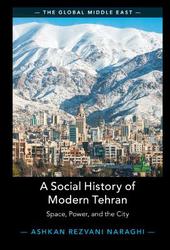
|
A Social History of Modern Tehran: Space, Power, and the City
Hardback
Main Details
| Title |
A Social History of Modern Tehran: Space, Power, and the City
|
| Authors and Contributors |
By (author) Ashkan Rezvani Naraghi
|
| Series | The Global Middle East |
|---|
| Physical Properties |
|
| ISBN/Barcode |
9781009188890
|
| Classifications | Dewey:306.09552509034 |
|---|
| Audience | |
|---|
| Illustrations |
Worked examples or Exercises
|
|
Publishing Details |
| Publisher |
Cambridge University Press
|
| Imprint |
Cambridge University Press
|
| Publication Date |
5 January 2023 |
| Publication Country |
United Kingdom
|
Description
Tehran, the capital of Iran since the late eighteenth century, is now one of the largest cities in the Middle East. Exploring Tehran's development from the nineteenth to the mid-twentieth century, Ashkan Rezvani Naraghi paints a vibrant picture of a city undergoing rapid and dynamic social transformation. Rezvani Naraghi demonstrates that this shift was the product of a developing discourse around spatial knowledge, in which the West became the model for the social practices of the state and sections of Iranian society. As traditional social spaces, such as coffee houses, bathhouses, and mosques, were replaced by European-style cafes, theatres, and sports clubs, Tehran and its people were irreversibly altered. Using an array of archival sources, Rezvani Naraghi stresses the agency of everyday inhabitants in shaping urban change. This enlightening history not only allows us to better understand the contours of contemporary Tehran, but to develop a new way of imagining, talking about, and building 'the city'.
Author Biography
Ashkan Rezvani Naraghi (1983-2020) was Assistant Professor in the School of Urban Planning and Design at the University of Tehran. He received his Ph.D. in Urban Studies from the University of Wisconsin-Milwaukee in 2016 and his article on middle-class urbanism appeared in Iranian Studies in 2017.
Reviews'In this meticulous and careful study, Tehran is no longer just a setting or even a contested site, but an almost living creature that shares in and shapes its inhabitants' lives and social transformations over time. This book is a gift from an insightful colleague who, though lost to us now, invites us to revisit our own work with fresh eyes and prods us towards new and productive lines of inquiry.' Camron Michael Amin, University of Michigan-Dearborn 'This book is a seminal analysis of the role of Tehran in Iran's social history. Based on a valuable array of primary material, it provides a unique window into the human and physical geographies of the capital during the turbulent social transformations of the first part of the twentieth century. A refreshing addition to our understanding of modern Iran.' Siavush Randjbar-Daemi, University of St Andrews
|